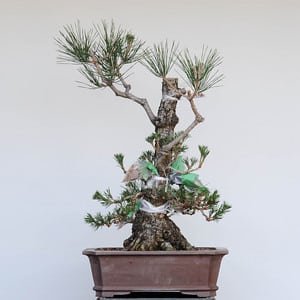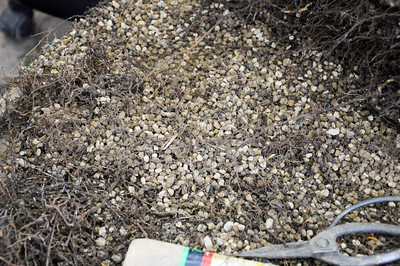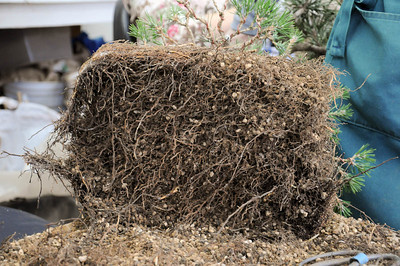I really like working with Japanese Black Pine. Although they keep needles year round, their appearance changes with the seasons. The pine below is flush with last year’s growth – a mix of spring and summer foliage.

Spring growth above – Summer growth below
As you might imagine, the future silhouette of this tree will be much smaller than it is now. I plan to remove the top half of the trunk when I get a few more grafts in place – more on that next week. After some cutback, needle pulling, grafting and repotting, the tree looked a bit more manageable.

All set for Spring
I learned years ago that bonsai folk can benefit from a deep sense of delayed gratification. Today this tree is both gangly and unbalanced – it looks like it’s waving its arms in the air in dismay. But it’s looking better every year and before long it will look great in an exhibit. The effort will be worth it.
I’ve also learned that there’s far more to bonsai than making trees “pretty.” Routine tasks like repotting provide me with plenty of gratification. While repotting this tree, I was very surprised to see the condition of the soil.

Bonsai soil after 3 years in the pot
After at least three years, the bonsai mix had barely begun to break down. I’d used Clay King – the pre-mixed bonsai soil that comes from Japan. It’s a mix of pumice, lava and akadama. Normally I’d expect to repot this tree every or at least every other year. It’s a large tree in a small pot and it’s growing vigorously. But because the soil is so hard, the drainage remained good and the roots developed well.

Combing out the roots
I also appreciate the time savings. Getting an extra year out of bonsai soil saves time and money. Getting that with no cost to the tree’s health is a super combination.
Subscribe to Bonsai Tonight
New Posts Delivered Every Tuesday and Friday
Dallas Roberts says
Hi Jonas, I was wondering where you get your clay King soil from? I live in Salt Lake City, and it seems my akadama always breaks down too quickly through the winter.
Thanks
xwires says
Hi Dallas – I likely got it from Jim Gremel (Deer Meadow Bonsai). I just bought a brand of akadama I haven’t used in years & will see how it goes. Finding the really good stuff is tricky.
Keith says
Hello Jonas, I just stumbled upon your blog and thought you might be able to answer a question regarding pine development. Japanese black pines are my favorite, so Ive been learning as much as I can about growing them for bonsai. Yet I have been unable to locate quality information about root development. I see all these great pines with strong nebari quickly turning into hair roots beneath the soil surface. How does one achieve that on a pine?
For example, lets say a pine has been allowed to grow for a few years to develop the trunk… there are several pencil thick roots at the base of the tree… When it is dug or re-potted, are all these thick roots cut way back at one time?
Thank you for sharing knowledge with those of us outside the bonsai community.
xwires says
Hi Keith – thanks for the note. And good question. I’ll briefly answer and mention that Bonsai Today #20 has a great article on growing Japanese black pine from seed – it’s well worth the read. If you’re growing the pines from seed, the first trick is making seedling-cuttings. If my seedlings germinate this season, I’ll be sure to write on the topic. The next part of the tree’s life is thickening the trunk. As long as the tree has some good lateral roots to start with, only basic root-work is completed in this phase. When the trunk gets to the desired size, the next step is developing fine branches and fine roots. These steps proceed hand in hand. During these years, large roots are removed and replaced, in time, with fine roots. Good bonsai soil and careful root-pruning make all the difference. Black pine roots can develop quickly under the right circumstances.
If you haven’t seen my earlier posts on the topic, you search this site for “bonsai soil” you’ll find a few posts about bonsai soil and repotting. I wrote about repotting basics here.